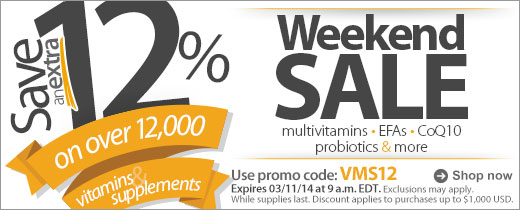
Source: Vitacost.com.
The health and wellness trend is one of the biggest forces impacting the consumer sector in recent years. In particular, the Nutrition Business Journal forecasts that the sales of vitamins, minerals, and supplements, or VMS, will grow from $32.5 billion in 2012 to $56.4 billion in 2020.
More important, growth in sales from the online channel is expected to significantly outpace that of the industry as a whole. Total VMS sales are expected to increase at a 2007-2020 compound annual growth rate of 6.8%, while the projected growth rate for e-commerce sales is almost double at 13.8%. Vitacost.com (NASDAQ: VITC), a leading online retailer of vitamins and dietary supplements, remains the best positioned to take advantage of the growing demand, as a result of its value positioning and merchandising strategy.

Source: Vitacost.com.
Healthy living can be affordable
Vitacost.com states that everyday low prices are one of its key value propositions to customers. According to a 2012 survey, the typical Vitacost.com customer is a married female with an average income of about $80,000. This puts Vitacost.com customers somewhere in the middle class, based on a September 2013 Wall Street Journal/NBC News poll in which the most number (29%) of respondents defined $50,000 to $75,000 as the middle class income range.
This suggests that while Vitacost.com customers have the affluence to switch to a healthier and more expensive diet, they are also relatively price sensitive. This is because the middle class population tend to be the hardest hit in any recession, as they aren't as rich as the high net-worth and also receive significantly less subsidies from the government than the lower income bracket.
Vitacost.com's internal surveys also indicated that its customers were highly analytical (did comparison of both products' features and pricing on various e-commerce websites) and usually committed to only buying small amounts for their initial purchases.
The survey results make a strong case for a low-price strategy, to which Vitacost.com has adhered. The company's product prices are lower than its competitors, according to a May 2013 survey. A basket of top 10 VMS stock-keeping units will cost Vitacost.com shoppers $155, compared with $164 for Amazon customers and $189 for Vitamin Shoppe (VSI) customers.
For those who buy Vitacost.com's private label products, the 10-item basket could be as cheap as $136. Without the rental cost burden from a brick and mortar presence, Vitacost.com boasts a lower cost structure than Vitamin Shoppe, allowing it to charge lower prices correspondingly.
Sprouts Farmers Market (SFM -3.94%) has also adopted value positioning. The grocery store chain's mission of "healthy living for less" seems to be a nod to Vitacost.com's slogan "take the cost out of healthy living." By offering similar products at lower prices than peers such as Whole Foods Market, Sprouts has managed to appeal to an increasing group of cost-conscious consumers seeking healthier food choices.
This is reflected in its superior financial performance relatively to the industry as a whole. Between 2008 and 2012, Sprouts Farmers Market grew its top line by a CAGR of 17.1%, compared with respective growth rates of 10.3% and 2.4% for natural and organic retailers and supermarkets.
Both Vitacost.com and Sprouts Farmers Market have made affordable healthy living a key selling point to attract consumers and have been rewarded with a loyal and growing customer base.
Unique and broad selection of products
Low prices are only one half of the equation; consumers also demand a wide variety of vitamins and dietary supplements that will meet their different needs. As a leading brick and mortar retailer of health and fitness goods, Vitamin Shoppe boasts a broad product selection of 8,000 SKUs from more than 400 brands. In addition, it is introducing about 100-150 new SKUs every month.
While these numbers sound impressive when considered in isolation, they pale in comparison to the breadth of Vitacost.com's online offerings. Vitacost.com has approximately 41,000 SKUs, of which 17,000 are VMS products and 7,000 are in the natural and organic food category. This is the advantage that clicks have over bricks, given that there is an natural cap on SKU expansion for offline retailers limited by store size.
Unique, proprietary products give retailers the edge in building customer loyalty, and both Vitacost.com and Vitamin Shoppe already have private label strategies in place. The rivals are equally matched on this count, boasting about 1,000 private label SKUs contributing about a fifth of their respective revenues. However, Vitacost.com has an edge when it comes to additional potential sales contribution from cross-selling efforts.
Although VMS products account for about 90% of Vitacost.com's private label products, the company has extended its proprietary products into new categories such as beauty and food to complement its core brand of nutraceuticals.
Foolish final thoughts
Vitacost.com has clearly earned the trust of its loyal customers with its value positioning and wide selection of both third-party and in-house brands. The results speak for themselves. Active customers, those who have purchased from Vitacost.com within the last 12 months, increased by 14.9% from 6.1 million in 2012 to 7 million in 2013. Going forward, Vitacost.com should be the key beneficiary of the growing health and wellness trend, as consumers demand lower prices and greater choices.




